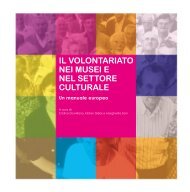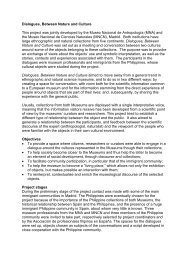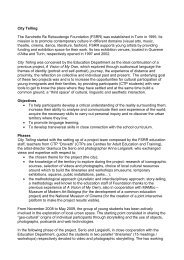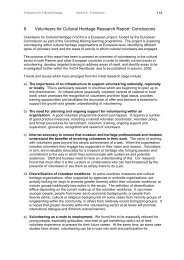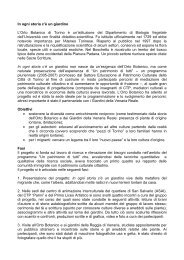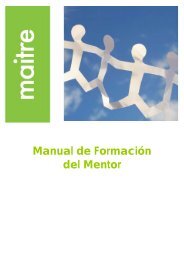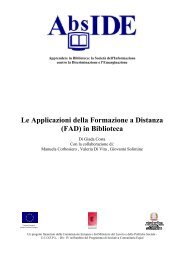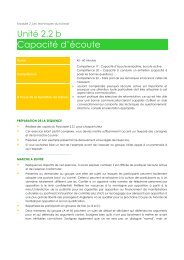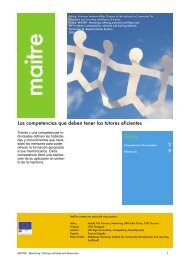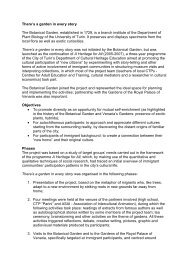Museums as places for intercultural dialogue - Network of European ...
Museums as places for intercultural dialogue - Network of European ...
Museums as places for intercultural dialogue - Network of European ...
You also want an ePaper? Increase the reach of your titles
YUMPU automatically turns print PDFs into web optimized ePapers that Google loves.
The whole process (delivery <strong>of</strong> 43 meetings, 100 hours <strong>of</strong> activitiesoverall), b<strong>as</strong>ed on a multi-sensory stimulation and on the interactionbetween individuals and artworks, w<strong>as</strong> documented through 1,500pictures and 10 hours <strong>of</strong> video recordings. The individual experiences<strong>of</strong> participants were “channelled” into an impressive spiral installation,presented during the closing event <strong>of</strong> the project. A selection <strong>of</strong> imagesw<strong>as</strong> carried out in order to create a photographic audiovisual which willbe copied and used <strong>for</strong> dissemination purposes.Whispering ShellsEchoes <strong>of</strong> Peoples, Cultures, ArtResultsThe most significant benefits <strong>for</strong> project participants were the discovery<strong>of</strong> the local heritage, active participation and involvement, andopportunities <strong>for</strong> collective and individual self-expression and creativecooperation.Whispering Shells also had an important impact <strong>for</strong> the museumeducators involved, who, thanks to the interaction with a highlydiverse audience (<strong>of</strong>ten with an extra-<strong>European</strong> background), had anopportunity to experiment with new strategies <strong>for</strong> cultural mediation.The plurality <strong>of</strong> participants’ perspectives w<strong>as</strong> encouraged with a viewto renegotiating the meaning <strong>of</strong> city collections and giving them a newvitality.Another strength <strong>of</strong> the project w<strong>as</strong> the joint work carried out inpartnership with secondary school and CTP teachers in terms <strong>of</strong>decision-making and process management.Torino Musei Foundation (FTM) incorporates four city museumspreserving a diverse heritage, ranging from ancient art from the MiddleAges to the nineteenth century (Palazzo Madama), to modern andcontemporary art (GAM - Gallery <strong>of</strong> Modern and Contemporary Art),the medieval and renaissance world in Piedmont and the Aosta Valley<strong>as</strong> reconstructed on the occ<strong>as</strong>ion <strong>of</strong> the Universal Exposition <strong>of</strong> 1884(Medieval Village), and Asian art (Museum <strong>of</strong> Oriental Art).In 2007-2008 the Education Department <strong>of</strong> GAM and Palazzo Madamaorganised the training course “Intercultural <strong>dialogue</strong> and city collections<strong>of</strong> ancient and modern art,” addressed to museum operators, teachers<strong>of</strong> primary and secondary school, and CTP educators. The keyidea underlying the Whispering Shells project – to use city museumcollections in order to experiment with <strong>intercultural</strong> trails and activities toinvolve migrant communities – originated from this experience and theencounter with a group <strong>of</strong> motivated teachers.Objectives• To adjust the educational mission <strong>of</strong> city museums to contemporarysocial changes;• To promote the knowledge <strong>of</strong> the city and its cultural heritage to anew audience;• To use heritage <strong>as</strong> a vehicle <strong>of</strong> interaction and exchange betweenindividuals with different cultural backgrounds, and <strong>as</strong> an impulse <strong>for</strong>individual and collective creativity;• To promote interpersonal <strong>dialogue</strong> and social inclusion throughshared experiences and feelings.Ph<strong>as</strong>esThe project drew inspiration from the shells represented throughout thecity collections: from Palazzo Madama’s Baroque decoration, to the stilllives <strong>of</strong> Filippo De Pisis displayed at GAM, to the coat <strong>of</strong> arms placedon the façade <strong>of</strong> the Pilgrims’ Hostel in the Medieval Village.Around this theme, the project team developed ad-hoc guided tours <strong>of</strong>the museums, and started a reflection on the personal memories andpoints <strong>of</strong> view <strong>of</strong> participants. The exchange <strong>of</strong> personal biographiesand narratives w<strong>as</strong> developed through oral and written storytelling,participatory games, listening to music and creative workshops. Theworkshops focused on the direct relationship between people andart and included photographic compositions made up <strong>of</strong> objects<strong>of</strong> personal or sentimental value to the owner inspired by the stilllife genre, and the creation <strong>of</strong> polychrome paintings <strong>for</strong> a collectiveinstallation (see below). A particular emph<strong>as</strong>is w<strong>as</strong> placed on therelational and interpersonal <strong>as</strong>pect <strong>of</strong> these activities.As <strong>for</strong> the project’s critical points, the initial intention to have adultsand students from different groups working together w<strong>as</strong> droppeddue to the high number <strong>of</strong> participants, and the differences in national/ cultural origin, literacy levels and social background. The projectteam opted instead <strong>for</strong> the well-tested patterns <strong>of</strong> school-museumpartnerships, and postponed the interaction between different groupsuntil the closing event.Future perspectivesIn the short term, FTM is planning to promote the project’s results bytouring the collective installation; the Director <strong>of</strong> Palazzo Madama iswilling to display it in the Museum <strong>of</strong> Ancient Art and to cooperate infuture similar initiatives.In the medium term, the Foundation hopes to ensure the legacy <strong>of</strong>the project by developing new opportunities <strong>of</strong> exchange and trainingaimed at securing a greater involvement <strong>of</strong> the museum staff <strong>as</strong> awhole.InstitutionTorino Musei Foundationwww.fondazionetorinomusei.itProject CoordinatorFlavia Barbaro, Head <strong>of</strong> Education, flavia.barbaro@fondazionetorinomusei.itTarget groupsNative and immigrant adult students <strong>of</strong> CTP “Drovetti” and “Braccini” (two local Centres<strong>for</strong> Adult Education and Training) and secondary school students. Overall, the projectinvolved six heterogeneous groups, made up <strong>of</strong> 123 people from 20 countries.42 43



